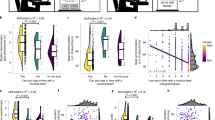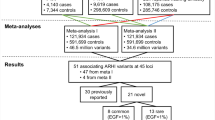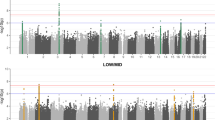Abstract
Humans have developed the perception, production and processing of sounds into the art of music. A genetic contribution to these skills of musical aptitude has long been suggested. We performed a genome-wide scan in 76 pedigrees (767 individuals) characterized for the ability to discriminate pitch (SP), duration (ST) and sound patterns (KMT), which are primary capacities for music perception. Using the Bayesian linkage and association approach implemented in program package KELVIN, especially designed for complex pedigrees, several single nucleotide polymorphisms (SNPs) near genes affecting the functions of the auditory pathway and neurocognitive processes were identified. The strongest association was found at 3q21.3 (rs9854612) with combined SP, ST and KMT test scores (COMB). This region is located a few dozen kilobases upstream of the GATA binding protein 2 (GATA2) gene. GATA2 regulates the development of cochlear hair cells and the inferior colliculus (IC), which are important in tonotopic mapping. The highest probability of linkage was obtained for phenotype SP at 4p14, located next to the region harboring the protocadherin 7 gene, PCDH7. Two SNPs rs13146789 and rs13109270 of PCDH7 showed strong association. PCDH7 has been suggested to play a role in cochlear and amygdaloid complexes. Functional class analysis showed that inner ear and schizophrenia-related genes were enriched inside the linked regions. This study is the first to show the importance of auditory pathway genes in musical aptitude.
This is a preview of subscription content, access via your institution
Access options
Subscribe to this journal
Receive 12 print issues and online access
$259.00 per year
only $21.58 per issue
Buy this article
- Purchase on Springer Link
- Instant access to full article PDF
Prices may be subject to local taxes which are calculated during checkout



Similar content being viewed by others
References
Perani D, Saccuman MC, Scifo P, Spada D, Andreolli G, Rovelli R et al. Functional specializations for music processing in the human newborn brain. Proc Natl Acad Sci USA 2010; 107: 4758–4763.
Koelsch S . Toward a neural basis of music perception—a review and updated model. Front Psychol 2011; 2: 1–20.
Peretz I, Zatorre RJ . Brain organization for music processing. Annu Rev Psychol 2005; 56: 89–114.
Baharloo S, Johnston PA, Service SK, Gitschier J, Freimer NB . Absolute pitch: an approach for identification of genetic and nongenetic components. Am J Hum Genet 1998; 62: 224–231.
Drayna D, Manichaikul A, de Lange M, Snieder H, Spector T . Genetic correlates of musical pitch recognition in humans. Science 2001; 291: 1969–1972.
Peretz I, Cummings S, Dubé M . The genetics of congenital amusia (tone deafness): a family-aggregation study. Am J Hum Genet 2007; 81: 582–588.
Pulli K, Karma K, Norio R, Sistonen P, Göring HHH, Järvelä I . Genome-wide linkage scan for loci of musical aptitude in Finnish families: evidence for a major locus at 4q22. J Med Genet 2008; 45: 451–456.
Theusch E, Basu A, Gitschier J . Genome-wide study of families with absolute pitch reveals linkage to 8q24.21 and locus heterogeneity. Am J Hum Genet 2009; 85: 112–119.
Park H, Lee S, Kim H, Ju YS, Shin J, Hong D et al. Comprehensive genomic analyses associate UGT8 variants with musical ability in a Mongolian population. J Med Genet 2012; 49: 747–752.
Karma K . Musical aptitude definition and measure validation: ecological validity can endanger the construct validity of musical aptitude tests. Psychomusicology 2007; 19: 79–90.
Seashore C, Lewis D, Saetveit J . Seashore Measures of Musical Talents (Manual). The Psychological Corp: New York, NY, USA, 1960.
Justus T, Hustler JJ . Fundamental issues in the evolutionary psychology of music: Assessing innateness and domain specificity. Music Perception 2005; 23: 1–27.
Ukkola-Vuoti L, Oikkonen J, Onkamo P, Karma K, Raijas P, Järvelä I . Association of the arginine vasopressin receptor 1A (AVPR1A) haplotypes with listening to music. J Hum Genet 2011; 56: 324–329.
Almasy L, Blangero J . Multipoint quantitative-trait linkage analysis in general pedigrees Am J Hum Genet 1998; 62: 1198–1211.
Purcell S, Neale B, Todd-Brown K, Thomas L, Ferreira MAR, Bender D et al. PLINK: a tool set for whole-genome association and population-based linkage analyses. Am J Hum Genet 2007; 81: 559–575.
O'Connell JR, Weeks DE . PedCheck: a program for identification of genotype incompatibilities in linkage analysis. Am J Hum Genet 1998; 63: 259–266.
Matise TC, Chen F, Chen W, De La Vega FM, Hansen M, He C et al. A second-generation combined linkage physical map of the human genome. Genome Res 2007; 17: 1783–1786.
Vieland VJ, Huang Y, Seok S, Burian J, Catalyurek U, O'Connell J et al. Kelvin: a software package for rigorous measurement of statistical evidence in human genetics. Hum Hered 2011; 72: 276–288.
Thomas A, Gutin A, Abkevich V, Bansal A . Multilocus linkage analysis by blocked Gibbs sampling. Statistics and computing 2000; 10: 259–269.
Huang Y, Thomas A, Vieland VJ . Employing MCMC under the PPL framework to analyze sequence data in large pedigrees. Front Genet 2013; 4: 59.
Bartlett CW, Vieland VJ . Accumulating quantitative trait linkage evidence across multiple datasets using the posterior probability of linkage. Genet Epidemiol 2007; 31: 91–102.
Smith CAB . Testing for heterogeneity of recombination fraction values in Human Genetics. Ann Hum Genet 1963; 27: 175–182.
Elston RC, Lange K . The prior probability of autosomal linkage. Ann Hum Genet 1975; 38: 341–350.
WTCC Consortium. Genome-wide association study of 14,000 cases of seven common diseases and 3,000 shared controls. Nature 2007; 447: 661–678.
Royall R . Statistical Evidence: A Likelihood Paradigm. CRC press Vol. 71 1997.
Vieland JV, Hodge SE . Review of statistical evidence: a likelihood paradigm. Am J Hum Genet 1998; 63: 283–289.
Vieland VJ . Thermometers: something for statistical geneticists to think about. Hum Hered 2006; 61: 144–156.
Meyer LR, Zweig AS, Hinrichs AS, Karolchik D, Kuhn RM, Wong M et al. The UCSC Genome Browser database: extensions and updates 2013. Nucleic Acids Res 2013; 41: D64–D69.
The International HapMap Consortium. The International HapMap Project. Nature 2003; 426: 789–796.
ENCODE Project Consortium, Bernstein BE, Birney E, Dunham I, Green ED, Gunter C et al. An integrated encyclopedia of DNA elements in the human genome. Nature 2012; 489: 57–74.
Zhou Y, Yamamoto M, Engel JD . GATA2 is required for the generation of V2 interneurons. Development 2000; 127: 3829–3838.
Kobayashi-Osaki M, Ohneda O, Suzuki N, Minegishi N, Yokomizo T, Takahashi S et al. GATA motifs regulate early hematopoietic lineage-specific expression of the Gata2 gene. Mol Cell Biol 2005; 25: 7005–7020.
Grass JA, Jing H, Kim S, Martowicz ML, Pal S, Blobel GA et al. Distinct functions of dispersed GATA factor complexes at an endogenous gene locus. Mol Cell Biol 2006; 26: 7056–7067.
Khandekar M, Brandt W, Zhou Y, Dagenais S, Glover TW, Suzuki N et al. A Gata2 intronic enhancer confers its pan-endothelia-specific regulation. Development 2007; 134: 1703–1712.
Wozniak RJ, Keles S, Lugus JJ, Young KH, Boyer ME, Tran TM et al. Molecular hallmarks of endogenous chromatin complexes containing master regulators of hematopoiesis. Mol Cell Biol 2008; 28: 6681–6694.
Nozawa D, Suzuki N, Kobayashi-Osaki M, Pan X, Engel JD, Yamamoto M . GATA2-dependent and region-specific regulation of Gata2 transcription in the mouse midbrain. Genes Cells 2009; 14: 569–582.
Wang Y, Tong X, Ye X . Ndfip1 negatively regulates RIG-I-dependent immune signaling by enhancing E3 ligase Smurf1-mediated MAVS degradation. J Immunol 2012; 189: 5304–5313.
Berkovic SF, Dibbens LM, Oshlack A, Silver JD, Katerelos M, Vears DF et al. Array-based gene discovery with three unrelated subjects shows SCARB2/LIMP-2 deficiency causes myoclonus epilepsy and glomerulosclerosis. Am J Hum Genet 2008; 82: 673–684.
Basit S, Lee K, Habib R, Chen L, Umm-e-Kalsoom, Santos-Cortez RLP et al. DFNB89, a novel autosomal recessive nonsyndromic hearing impairment locus on chromosome 16q21-q23.2. Hum Genet 2011; 129: 379–385.
Grillet N, Schwander M, Hildebrand MS, Sczaniecka A, Kolatkar A, Velasco J et al. Mutations in LOXHD1, an evolutionarily conserved stereociliary protein, disrupt hair cell function in mice and cause progressive hearing loss in humans. Am J Hum Genet 2009; 85: 328–337.
Haugas M, Lilleväli K, Hakanen J, Salminen M . Gata2 is required for the development of inner ear semicircular ducts and the surrounding perilymphatic space. Dev Dyn 2010; 239: 2452–2469.
Lahti L, Achim K, Partanen J . Molecular regulation of GABAergic neuron differentiation and diversity in the developing midbrain. Acta Physiol (Oxf) 2013; 207: 616–627.
De Martino F, Moerel M, van de Moortele P, Ugurbil K, Goebel R, Yacoub E et al. Spatial organization of frequency preference and selectivity in the human inferior colliculus. Nat Commun 2013; 4: 1386.
Caspary D, Milbrandt JC, Helfert RH . Central auditory aging: gaba changes in the inferior colliculus. Exp Gerontol 1995; 30: 349–360.
Van Esch H, Groenen P, Nesbit MA, Schuffenhauer S, Lichtner P, Vanderlinden G et al. GATA3 haplo-insufficiency causes human HDR syndrome. Nature 2000; 406: 419–422.
Lin J, Yan X, Wang C, Guo Z, Rolfs A, Luo J . Anatomical expression patterns of delta-protocadherins in developing chicken cochlea. J Anat 2012; 221: 598–608.
Hertel N, Redies C, Medina L . Cadherin expression delineates the divisions of the postnatal and adult mouse amygdala. J Comp Neurol 2012; 520: 3982–4012.
Gosselin N, Peretz I, Johnsen E, Adolphs R . Amygdala damage impairs emotion recognition from music. Neuropsychologia 2007; 45: 236–244.
Sotomayor M, Weihofen WA, Gaudet R, Corey DP . Structure of a force-conveying cadherin bond essential for inner-ear mechanotransduction. Nature 2012; 492: 128–132.
Ahmed ZM, Riazuddin S, Bernstein SL, Ahmed Z, Khan S, Griffith AJ et al. Mutations of the protocadherin gene PCDH15 cause Usher syndrome type 1F. Am J Hum Genet 2001; 69: 25–34.
Katz E, Elgoyhen AB, Gómez-Casati ME, Knipper M, Vetter DE, Fuchs PA et al. Developmental regulation of nicotinic synapses on cochlear inner hair cells. J Neurosci 2004; 24: 7814–7820.
Ousdal OT, Anand Brown A, Jensen J, Nakstad PH, Melle I, Agartz I et al. Associations between variants near a monoaminergic pathways gene (PHOX2B) and amygdala reactivity: a genome-wide functional imaging study. Twin Res Hum Genet 2012; 15: 273–285.
Metz M, Gassmann M, Fakler B, Schaeren-Wiemers N, Bettler B . Distribution of the auxiliary GABAB receptor subunits KCTD8, 12, 12b, and 16 in the mouse brain. J Comp Neurol 2011; 519: 1435–1454.
Di Pasquale G, Davidson BL, Stein CS, Martins I, Scudiero D, Monks A et al. Identification of PDGFR as a receptor for AAV-5 transduction. Nat Med 2003; 9: 1306–1312.
Ballana E, Wang J, Venail F, Estivill X, Puel J, Arbonès ML et al. Efficient and specific transduction of cochlear supporting cells by adeno-associated virus serotype 5. Neurosci Lett 2008; 442: 134–139.
Ukkola LT, Onkamo P, Raijas P, Karma K, Järvelä I . Musical aptitude is associated with AVPR1A-haplotypes. PLoS One 2009; 4: e5534.
Karma K . Auditory and visual temporal structuring: how important is sound to musical thinking? Psychology of Music 1994; 22: 20–30.
Tervaniemi M, Ilvonen T, Karma K, Alho K, Näätänen R . The musical brain: brain waves reveal the neuropsychological basis of musicality in human subjects. Neuroscience letters 1997; 226: 1–4.
Salimpoor VN, van den Bosch I, Kovacevic N, McIntosh AR, Dagher A, Zatorre RJ . Interactions between the nucleus accumbens and auditory cortices predict music reward value. Science 2013; 340: 216–219.
Herholz SC, Zatorre RJ . Musical training as a framework for brain plasticity: behavior, function, and structure. Neuron 2012; 76: 486–502.
Acknowledgements
We are grateful to the families for their participation. We thank the High-Throughput Genomics Group at the Wellcome Trust Centre for Human Genetics (funded by Wellcome Trust grant reference 090532/Z/09/Z and MRC Hub grant G0900747 91070) for the generation of the genotype data. Daniel Borshagovski is thanked for information about the regulatory elements. Johanna Lumme is thanked for the artwork and Minna Varhala for her expert laboratory work. Funding for this study was provided by the Academy of Finland #13371, the Finnish Cultural Foundation to IJ. LUV is funded by the Helsinki University Research Foundation and the Paulo Foundation. VJV is funded by the National Institutes of Health (grant R01 MH086117 and U24 MH068457). This work was also supported in part by an allocation of computing time from the Ohio Supercomputer Center Grant PCCR0002 to VJV.
Author information
Authors and Affiliations
Corresponding author
Ethics declarations
Competing interests
The authors declare no conflict of interest.
Additional information
Supplementary Information accompanies the paper on the Molecular Psychiatry website
Supplementary information
Rights and permissions
About this article
Cite this article
Oikkonen, J., Huang, Y., Onkamo, P. et al. A genome-wide linkage and association study of musical aptitude identifies loci containing genes related to inner ear development and neurocognitive functions. Mol Psychiatry 20, 275–282 (2015). https://doi.org/10.1038/mp.2014.8
Received:
Revised:
Accepted:
Published:
Issue Date:
DOI: https://doi.org/10.1038/mp.2014.8
Keywords
This article is cited by
-
Biological principles for music and mental health
Translational Psychiatry (2023)
-
Music compensates for altered gene expression in age-related cognitive disorders
Scientific Reports (2023)
-
How far musicality and perfect pitch are derived from genetic factors?
Journal of Applied Genetics (2020)
-
Factors affecting pitch discrimination performance in a cohort of extensively phenotyped healthy volunteers
Scientific Reports (2017)
-
Heritability of non-speech auditory processing skills
European Journal of Human Genetics (2016)



